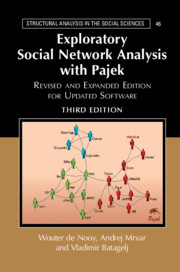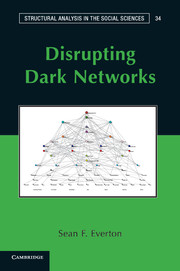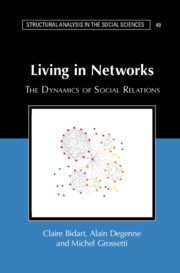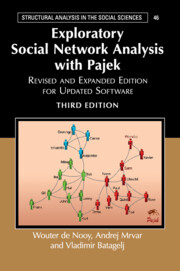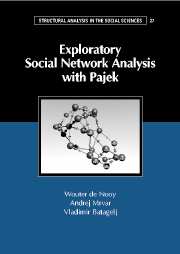
Exploratory Social Network Analysis with Pajek
$49.00 USD
Part of Structural Analysis in the Social Sciences
- Authors:
- Wouter de Nooy, Erasmus Universiteit Rotterdam
- Andrej Mrvar, University of Ljubljana
- Vladimir Batagelj, University of Ljubljana
- Date Published: September 2005
- availability: This ISBN is for an eBook version which is distributed on our behalf by a third party.
- format: Adobe eBook Reader
- isbn: 9780511123566
Find out more about Cambridge eBooks
$
49.00 USD
Adobe eBook Reader
Looking for an inspection copy?
Please email [email protected] to enquire about an inspection copy of this book
-
This was the first textbook on social network analysis integrating theory, applications, and professional software for performing network analysis (Pajek). Step by step, the book introduces the main structural concepts and their applications in social research with exercises to test the understanding. An application section explaining how to perform the network analyses with Pajek software follows each theoretical section. Pajek software and datasets for all examples are freely available, so the reader can learn network analysis by doing it. In addition, each chapter offers case studies for practising network analysis. In the end, the reader has the knowledge, skills, and tools to apply social network analysis in all social sciences, ranging from anthropology and sociology to business administration and history.
Read more- Learning by doing: hands-on experience from day one with Pajek professional computer software for network analysis and visualization (operating under Windows 95 and later), computer procedures are extensively discussed and illustrated
- Each chapter starts with visual exploration, followed by computation of formal indices, because visualization helps to understand the structural feature summarized by an index. No formulae; concepts from mathematical graph theory are presented verbatim and visually
- An introduction to basic concepts from network analysis as well as their application in the social sciences; network concepts are presented in the frame of social theory; a wide variety of real life examples from several social sciences, which demonstrate research strategies in social network analysis
Customer reviews
Not yet reviewed
Be the first to review
Review was not posted due to profanity
×Product details
- Date Published: September 2005
- format: Adobe eBook Reader
- isbn: 9780511123566
- contains: 179 b/w illus.
- availability: This ISBN is for an eBook version which is distributed on our behalf by a third party.
Table of Contents
Part I. Fundamentals
Section 1. Looking for Social Structure:
1. Introduction
2. Sociometry and sociogram
3. Exploratory social network analysis
4. Assembling a social network
5. Summary
6. Questions
7. Assignment
8. Further reading
9 Answers
Section 2. Attributes and Relations:
1. Introduction
2. Example: the world system
3. Partitions
4. Reduction of a network
5. Vectors and coordinates
6. Network analysis and statistics
7. Summary
8. Questions
9. Assignment
10. Further reading
11. Answers
Part II. Cohesion
Section 3. Cohesive Subgroups:
1. Introduction
2. Example
3. Density and degree
4. Components
5. Cores
6. Cliques and complete subnetworks
7. Summary
8. Questions
9. Assignment
10. Further reading
11. Answers
Section 4. Sentiments and Friendship:
1. Introduction
2. Balance theory
3. Example
4. Detecting structural balance and clusterability
5. Development in time
6. Summary
7. Questions
8. Assignment
9. Further reading
10. Answers
Section 5. Affiliations:
1. Introduction
2. Example
3. Two-mode and one-mode networks
4. M-slices
5. The third dimension
6. Summary
7. Questions
8. Assignment
9. Further reading
10. Answers
Part III. Brokerage: Section 6. Center and periphery:
1. Introduction
2. Example
3. Distance
4. Betweenness
5. Summary
6. Questions
7. Assignment
8. Further reading
9. Answers
Section 7. Brokers and Bridges:
1. Introduction
2. Example
3. Bridges and bi-components
4. Ego-networks and constraint
5. Affiliations and brokerage roles
6. Summary
7. Questions
8. Assignment
9. Further reading
10. Answers
Section 8. Diffusion:
1. Example
2. Contagion
3. Exposure and thresholds
4. Critical mass
5. Summary
6. Questions
7. Assignment
8. Further reading
9. Answers
Part IV. Ranking: Section 9. Prestige:
1. Introduction
2. Example
3. Popularity and indegree
4. Correlation
5. Domains
6. Proximity prestige
7. Summary
8. Questions
9. Assignment
10. Further reading
11. Answers
Section 10. Ranking:
1. Introduction
2. Example
3. Triadic analysis
4. Acyclic networks
5. Symmetric-acyclic decomposition
6. Summary
7. Questions
8. Assignment
9. Further reading
10. Answers
Section 11. Genealogies and Citations:
1. Introduction
2. Example I: Genealogy of the Ragusan nobility
3. Family trees
4. Social research on genealogies
5. Example II: Citations among papers on network centrality
6. Citations
7. Summary
8. Questions
9. Assignment 1
10. Assignment 2
11. Further reading
12. Answers
Part V. Roles: Section 12. Blockmodels
1. Introduction
2. Matrices and permutation
3. Roles and positions: equivalence
4. Blockmodeling
5. Summary
6. Questions
7. Assignment
8. Further reading
9 Answers
Appendices.
Sorry, this resource is locked
Please register or sign in to request access. If you are having problems accessing these resources please email [email protected]
Register Sign in» Proceed
You are now leaving the Cambridge University Press website. Your eBook purchase and download will be completed by our partner www.ebooks.com. Please see the permission section of the www.ebooks.com catalogue page for details of the print & copy limits on our eBooks.
Continue ×Are you sure you want to delete your account?
This cannot be undone.
Thank you for your feedback which will help us improve our service.
If you requested a response, we will make sure to get back to you shortly.
×
